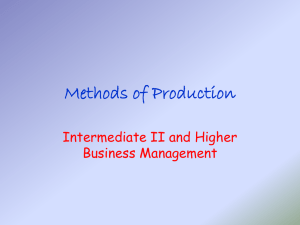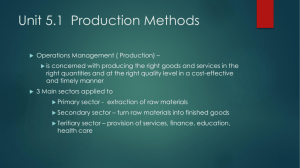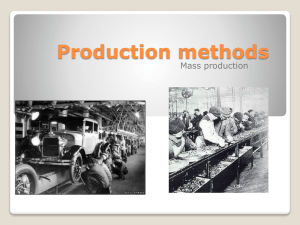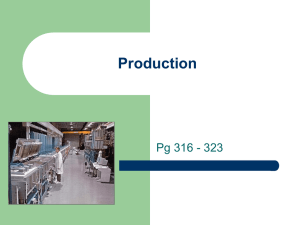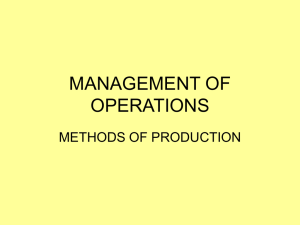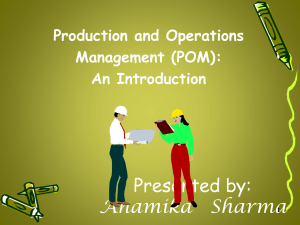5.2 Methods of Production KGL
advertisement
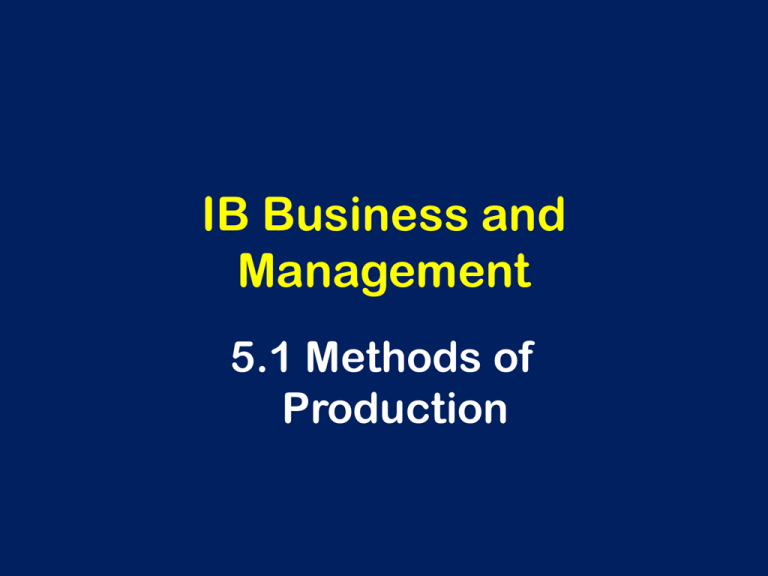
IB Business and Management 5.1 Methods of Production Learning Outcomes • To understand and be able to apply the following production methods: (AO2) • Job (customised) • Batch • Flow (mass) • Cellular Manufacturing • To be able to evaluate the most appropriate method of production for a given situation (AO3) Central Question What impact will 3D printing have on traditional methods of production in the future? Production – lets watch some videos on how different products are made – consider: • Process in which raw materials, components and finished goods are converted into new goods or services. What are the raw materials and components? What processes do they go through? What is the final Good or Service? Production Plan • Incorporates the Objectives and Functions of the whole business • Before production begins, major decisions have to be made – – Plant layout – Degree of automation – Scale of production – Method of Production – Types of quality controls required • • • • • Choice of production depends on: The product being produced The size of the market The size of the business The finance available The technology available Methods of production Size of production Small Job Batch Flow High METHODS OF PRODUCTION Production Methods: • • • • • Job Production Batch Production Mass/Flow/ Process Production Mass Production Cellular Manufacturing The method of production chosen will have implications for: • Ability to benefit from economies of scale • Capital requirements • Labour costs (a factor of the number and skill of the labour force required) • Lead times • Flexibility • Made-to-Measure or Standardised? • Quality of products • Employee motivation • Price that customers are prepared to pay Job Production • Job production involves firms producing items that meet the specific requirements of the customer. • Often these are one-off, unique items • A single worker or group of workers handles the complete task. • Goods are normally only produced once there is an order for them Batch Production • Goods are produced in lots or batches • Goods produced are similar, or differ in one respect such as shape or colour or size • When one batch is finished the machines may have to be re-set before moving on to the next batch Flow/Line Production • Flow production is a form of mass production where different operations are progressively carried out in sequence (assembly line) • When one task is complete, the next stage must start immediately • Often capital intensive Mass Production • Mass production involves producing large amounts of a standardised product • Identical products are produced in large quantities Task – Production Experiment You will be split into 3 teams Each team will use a different method of production After the experiment you will feed back to the rest of the group about your results Discussion Questions 1. Which method of production ensures the highest quality dice? 2. Which method of production ensures the maximum number of dice? 3. Which method of production made the most profit? Why? 5. Which method of production offers the opportunity for a variety of products? 6. Which method of production requires very high-skilled labour? 7. Which method of production caters best customers’ individual needs and wants? 8. Which type of production ended up with the biggest amount of Work in Progress at the end of the task? Why might this be a problem for a business? TASK – WHICH METHOD/METHODS OF PRODUCTION? For each of the following types of product….. • Which is the most likely method to be used? • Are any other methods suitable? • Can you think of examples of businesses that might use these method of production to make this product? • Are any of the production methods definitely not suitable? Why? Air Craft Housing Cars Newspapers Suits Task • In groups discuss the methods of production that we have looked at • Comment on these factors in the table provided • Ability to benefit from economies of scale • Capital requirements • Labour costs (a factor of the number and skill of the labour force required) • Lead times • Flexibility • Made-to-Measure or Standardised? • Quality of products • Employee motivation • Price that customers are prepared to pay Labour Vs Capital Intensity • Labour Intensive production is where more labour (in terms of cost) is used in production than any other input • Capital Intensive production is where production relies more heavily on capital (machinery) Chocolate Video • Watch the video and think about: • What factors do you need to consider when choosing between labour or capital intensive approach to production? Questions: • What factors have lead to many businesses becoming more capital intensive? • What are the advantages of businesses becoming more capital intensive? • What are the disadvantages of being capital intensive? • Why is capital intensity less suitable for businesses in the Tertiary sector? • Which methods of production (batch, job, flow) are usually more capital intensive? Combining Methods of Production • In reality many manufacturers combine methods of production Example- Jaguar • The Jaguar factory near Coventry UK uses highly automated flow production. • However as every car is made to order, at a point in the production process job production is used to add the elements to meet the customers specification What about for our Case study companies? Task in pairs – 5 mins • When businesses change their production techniques there will be implications for the different functional areas of the business. • Human Resources • Finance • Marketing What might these implications be? Can you find an example from our case study companies? CELLULAR MANUFACTURING Watch the videos and consider: • • • • • What is Cellular Manufacturing What does it hope to achieve Benefits? Drawbacks? Which products or industries would be suited to this method? Features of Cell Manufacturing • Cell production has the flow production line split into a number of self-contained units. • Each team or ‘cell’ is responsible for a significant part of the finished article • team members are skilled at a number of roles, so it provides a means for job rotation. What would be the advantages and potential disadvantages of organising production in cells? Advantages • • • • • • Workers have autonomy Workers have loyalty to their team Teams given responsibility Inter-cell competitiveness Variety of work Multiskilled workforce Disadvantages • • • • • Lower productivity than mass production? Potential conflict within teams Conflict between cells if one cell ends up waiting Duplication of machinery? Initial training costs Which Method To Choose? • Choose one of our companies and analyse its current method(s) of production • Are they appropriate? • Have they changed over time – if so why? Will 3D printing change the production and operations management landscape? What are the threats and opportunities for businesses? Concepts CONCEPT CHANGE CULTURE ETHICS GLOBALISATION INNOVATION STRATEGY RELEVANCE TO METHODS OF PRODUCTION
